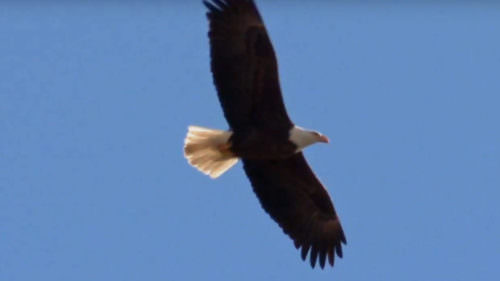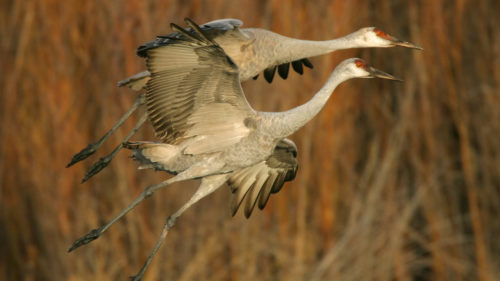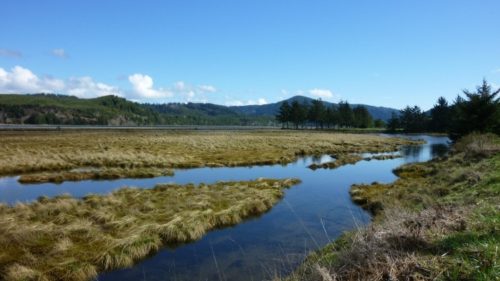On a clear day, the view from Bonney Butte onto southern flanks of Mount Hood is brilliant and awesome.
Raptor specialist Dan Sherman said that his camouflaged blind is the “best seat of the house:”
“Well, there aren’t many offices that have a view out a window like this one. I look straight in front toward Mt Hood and then off to the west as well and as I look, I pick out all the little black dots.”
Sherman is part of Hawkwatch International‘s ‘Raptor Banding Team’ and those “little black dots” will take your breath away when they become big raptor birds that soar right overhead.
Sometimes they do more than soar – they also attack.
That’s what happened when a large red tail hawk swooped in to Sherman’s site and with its razor sharp talons became entangled in a fine mesh fabric called a “mist net.”
The net panels surrounded a feathered prey called a ‘lure.”
Sherman wasted little time removing the big broad-winged raptor.
He carefully bundled up the bird’s legs, talons and wings and held it close to his chest.
“Most red tails are not biters,” he noted. “But occasionally you’ll get one that will lunge at you. I am sure that if I stuck my finger in its face it would bite it. Well, that was the hard part, now let’s process her.”
Sherman and fellow team member Jade Ajani quickly and quietly weighed, measured and banded the captured bird.
“It can be pretty exciting when you’re working with hawks,” whispered Sherman – a 12-season veteran at the stunning locale called Bonney Butte.
He added with a smile, “These birds can really make the adrenalin flow!”
Bonney Butte is on a ridgeline that runs north and east of Mt Hood toward the Columbia River.
It is a place where the raptors would rather soar than flap their wings.
“The birds are migrating south and looking out for other birds,” noted Ajani.
“They look to see if other birds have good lift from thermal updrafts that are created off the ridges. Plus, you often have westerly winds that hit the ridges and create the lift – that is what the birds are after – saves them energy to soar or glide rather than fly.”
Birds are drawn to the capture site by feathered non-native prey called a “lure”
Sherman jerked a cord that lifted the lure and another sharp-eyed raptor was decoyed into the mist net panels.
Speed is everything in the capture and banding process. Not only to free the trapped raptor and catch more, but if stranded too long, the predator can easily become prey of another soaring raptor.
The team will capture scores of raptors on any given fall day and usually half a dozen species are represented.
Some, like a sharp-shinned hawk that Ajani held tight prior to release, sported a razor sharp beak.
They are fascinating birds that are rarely seen so close.
A half-mile away, several volunteer “observers” were perched on a rocky outcropping of the Bonney Butte ridge.
Hawkwatch International’s Adam Baz said that the ever-watchful volunteers count every raptor species they can from one of the most remarkable view sites in Oregon
“We can see 7 and sometimes 8 different mountains from up here – that view coupled with the amount of hawks that come through here make it a really incredible place to work.
Hawkwatch International has been monitoring, trapping and banding hundreds of raptors since they began operation atop Bonney Butte in 1994.
Their record of raptors has helped to contribute new understanding of birds that travel from the Arctic to Central America.
Bonney Butte’s geography makes it a first rate laboratory!
“The diversity of species we get here is astounding,” noted Baz. “On any given day we will see every species of hawk in the area, plus eagles and falcons too. It is amazing!”
It is also open to visitors every day.
If you come – bring water,” added Baz with a chuckle. “The weather changes quickly up here too, so a rain jacket is a good idea. A camera, binoculars and hiking boots are ‘must haves’ as well.”
I hope you make time to visit Bonney Butte for there’s simply no other place like it in Oregon. If you go, know that the drive is long, the road is extremely rocky and the site is remote. Be prepared and allow for a two-hour trip from Portland.
Hawkwatch International continues the capture and banding and observation work at Bonney Butte through October.



